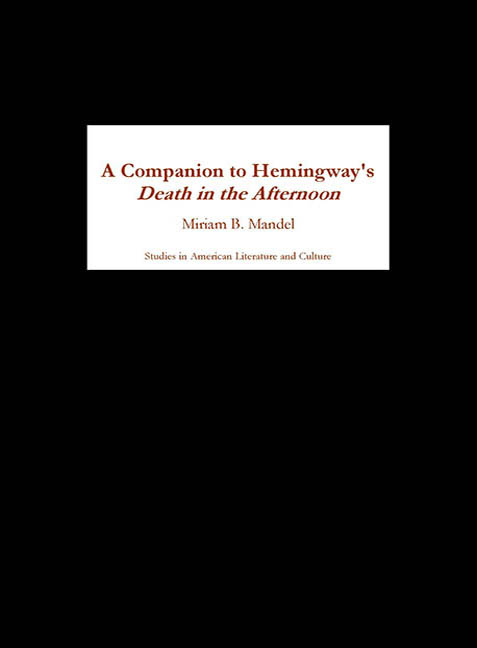Book contents
- Frontmatter
- Dedication
- Contents
- Acknowledgments
- Hemingway Works That Address the Bullfight
- A Note on the Text of Death in the Afternoon
- Introduction
- Composition, Sources, and Backgrounds
- Reading Texts, Paratexts, and Absence
- On Authorship and Art
- And What Came After
- The Legacy of Death in the Afternoon: Norman Mailer and Barnaby Conrad
- Works Cited
- Notes on the Contributors
- Index
The Legacy of Death in the Afternoon: Norman Mailer and Barnaby Conrad
from And What Came After
Published online by Cambridge University Press: 27 April 2017
- Frontmatter
- Dedication
- Contents
- Acknowledgments
- Hemingway Works That Address the Bullfight
- A Note on the Text of Death in the Afternoon
- Introduction
- Composition, Sources, and Backgrounds
- Reading Texts, Paratexts, and Absence
- On Authorship and Art
- And What Came After
- The Legacy of Death in the Afternoon: Norman Mailer and Barnaby Conrad
- Works Cited
- Notes on the Contributors
- Index
Summary
All modern American taurine writing comes from one book by Ernest Hemingway called Death in the Afternoon. There was almost nothing before. There has been nothing as good since. But there has been a great deal. The thirty-fifth anniversary edition of La Busca, a bibliography of books in English concerning bullfighting through 1999, contains approximately two thousand items (Phelps, Brody, and Tuttle). This is quantitatively impressive, even if one discounts items that deal with the subject only in a chapter or two or those that appeared before 1932.
Any effort to survey more than a fraction of these works, even if limited to those directly indebted to Death in the Afternoon, is bound to be superficial. Instead, this essay will consider only two writers, Norman Mailer and Barnaby Conrad, one a major figure in American literature of the last half century, the other a freelance writer who has written more on the bulls than any other American or British author. Both write under the clearly discernible shadow of Ernest Hemingway in general and of Death in the Afternoon in particular.
Of all American writers of importance, Norman Mailer has been the most fascinated by Hemingway's life and personality. Indeed, his carefully cultivated macho image has often seemed a comic parody of his model. As a freshman at Harvard he read Hemingway and such other “tough” writers as John Dos Passos, John Steinbeck, and James T. Farrell. In a creative writing class with Robert Gorham Davis he wrote “a Hemingwayesque exercise about a bellhop with a bloody ending” that met the approval of Davis but induced only laughter from his classmates, anti-Semitic or not, because it seemed so incongruous coming from a sixteen-year-old Jewish boy from Crown Heights (Dearborn, 27). This was the first of many literary efforts during Mailer's long career in which Hemingway's literary influence was apparent.
We do not know precisely when Mailer read Death in the Afternoon, but he surely read it before, during, or shortly after his summer trips to Mexico in 1954 and 1955, when he saw many bullfights, befriended bullfighters who explained the finer points to him, and even planned, with some friends, to rent a small ring and have a novillada of their own — a plan that was never realized.
- Type
- Chapter
- Information
- A Companion to Hemingway's Death in the Afternoon , pp. 283 - 300Publisher: Boydell & BrewerPrint publication year: 2004

